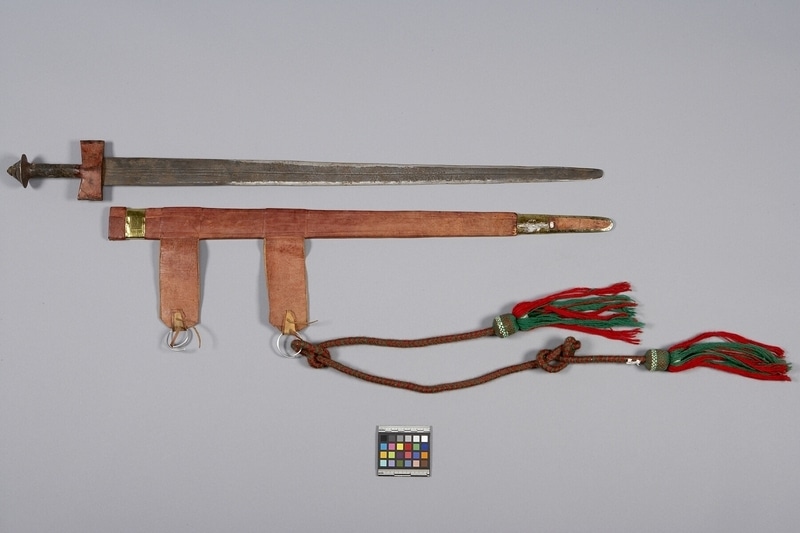Sword Item Number: Cc2 a-c from the MOA: University of British Columbia


Description
Sword (part a) with scabbard (part b) and cord (part c). Sword has a double-edged blade with two crescents on either side at the hilt end. Hilt is covered with brown leather decorated on each side with a star of four intersecting lines on one side and two n's on other side. Pommel is decorated with brass and steel caps superimposed on each other. Grip is covered with black leather. Scabbard is brown leather stretched and sewn over a wood frame with two brown leather rectangular straps. There are two tin bands at either end wrapped around and decorated with excised star and punched dots to make a stippled line around all edges. Chape of scabbard is tan leather and edged with tin. Cord of red and green wool with a tassel at either end is braided over a central core and knotted to the straps.
History Of Use
Takouba swords are common among communities throughout Sahelian Africa. In many communities in the Sahel, these swords were an important tool for traditional dances and ceremonial duels. They would be given to male children after birth by their mothers and used with shields of camel hide. In the modern-day, these swords are still worn as part of traditional regalia at cultural events. The takouba sword design, with its iconic hilt shape, evolved out of Arabian swords that spread into Africa with the spread of Islam. The use of this design by a Nupe artist is likely the result of interaction with Islamic communities in the northern part of Nigeria. The two leather straps on the scabbard are designed to be connected to a belt or baldric for ease of carrying.
Narrative
Bought by the donor in central market of Kano.
Item History
- Made in Kano, Nigeria
- Owned by John Bannister before September 23, 1977
- Received from John Bannister (Donor) on September 23, 1977
What
- Name
- Sword
- Identification Number
- Cc2 a-c
- Type of Item
- sword
- Material
- steel metal, leather skin, wool fibre and wood
- Manufacturing Technique
- incised, punched and braided
- Overall
- height 10.0 cm, width 99.0 cm, depth 4.6 cm
Who
- Culture
- Nupe ?
- Previous Owner
- John Bannister
- Received from
- John Bannister (Donor)
Where
- Holding Institution
- MOA: University of British Columbia
- Made in
- Kano, Nigeria
When
- Ownership Date
- before September 23, 1977
- Acquisition Date
- on September 23, 1977
Other
- Item Classes
- metalwork
- Condition
- fair
- Accession Number
- 0417/0001 a-c